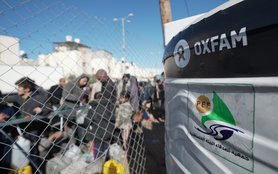Typhoon Hagupit has struck the Philippines, making landfall yesterday night, 6 December, in Dolores, Samar, in Visayas (Central Philippines). The Philippines office of international humanitarian organization Oxfam has been activating contingency plans and readying stocks of emergency assistance, including hygiene and clean water kits and water bladders that can support water supply to evacuations centers.
Oxfam has staff on the ground in Leyte and Eastern Samar provinces in the Visayas and Oxfam's rapid assessment teams, comprised of experts in livelihoods, water and sanitation, protection and gender, are ready to be immediately deployed in affected areas as soon as conditions are safe enough. Oxfam staff across the country are on standby, ready to support an emergency response if needed.
The typhoon, known locally as Ruby, hit Samar, which is still recovering from the destruction caused by Super Typhoon Haiyan. Haiyan decimated the central region of the archipelago last year, killing more than 6,300 people and forcing 4 million people to leave their homes. Hagupit made another landfall today, in Masbate, and is projected to make three more landfalls, including one close to the country's capital, Metro Manila.
Justin Morgan, country director of the Philippines program of Oxfam, said the government's massive pre-emptive evacuation has saved many lives.
“The Philippine government has just led one of the world’s largest peacetime evacuations across hazard-prone areas in the typhoon’s projected path. Oxfam and the wider humanitarian community are on standby, willing to assist where and when needed,” said Morgan. The government's disaster agency, the National Disaster Risk Reduction and Management Council, places the number of evacuees at 896,011.
“Depending on the extent of the damage on their homes, hundreds of thousands of displaced communities will need support in the next few days or weeks. Oxfam also remains concerned about the situation of those households that are still struggling to recover from typhoon Haiyan, often living in inadequate shelter unable to withstand significant winds and rain, and living in deeper poverty because of ongoing difficulties in fully resuming key livelihoods activities. These households will likely be to most impacted by typhoon Hagupit,” Morgan said.
“Because of the sheer number of evacuees, evacuation centers could be overstretched and will result in health and sanitation issues. We also know that women and girls are more vulnerable in evacuation centers, at risk to harassment and sexual violence,” said Morgan.


